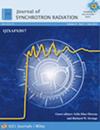PINK: a tender X-ray beamline for X-ray emission spectroscopy.
IF 2.4
3区 物理与天体物理
Q2 INSTRUMENTS & INSTRUMENTATION
引用次数: 0
Abstract
A high-flux beamline optimized for non-resonant X-ray emission spectroscopy (XES) in the tender X-ray energy range has been constructed at the BESSY II synchrotron source. The beamline utilizes a cryogenically cooled undulator that provides X-rays over the energy range 2.1 keV to 9.5 keV. This energy range provides access to XES [and in the future X-ray absorption spectroscopy (XAS)] studies of transition metals ranging from Ti to Cu (Kα, Kβ lines) and Zr to Ag (Lα, Lβ), as well as light elements including P, S, Cl, K and Ca (Kα, Kβ). The beamline can be operated in two modes. In PINK mode, a multilayer monochromator (E/ΔE ≃ 30-80) provides a high photon flux (1014 photons s-1 at 6 keV and 300 mA ring current), allowing non-resonant XES measurements of dilute substances. This mode is currently available for general user operation. X-ray absorption near-edge structure and resonant XAS techniques will be available after the second stage of the PINK commissioning, when a high monochromatic mode (E/ΔE ≃ 10000-40000) will be facilitated by a double-crystal monochromator. At present, the beamline incorporates two von Hamos spectrometers, enabling time-resolved XES experiments with time scales down to 0.1 s and the possibility of two-color XES experiments. This paper describes the optical scheme of the PINK beamline and the endstation. The design of the two von Hamos dispersive spectrometers and sample environment are discussed here in detail. To illustrate, XES spectra of phosphorus complexes, KCl, TiO2 and Co3O4 measured using the PINK setup are presented.PINK:用于 X 射线发射光谱分析的 X 射线光束线。
在 BESSY II 同步辐射光源建造了一条高通量光束线,该光束线针对嫩 X 射线能量范围内的非共振 X 射线发射光谱(XES)进行了优化。该光束线利用一个低温冷却减压器,提供能量范围为 2.1 keV 至 9.5 keV 的 X 射线。在这一能量范围内,可以对从钛到铜(Kα、Kβ线)、从锆到银(Lα、Lβ)的过渡金属以及包括P、S、Cl、K和Ca(Kα、Kβ)在内的轻元素进行XES[以及未来的X射线吸收光谱(XAS)]研究。该光束线可在两种模式下运行。在 PINK 模式下,多层单色仪(E/ΔE ≃ 30-80)提供高光子通量(6 keV 和 300 mA 环电流时为 1014 光子 s-1),可对稀释物质进行非共振 XES 测量。该模式目前可供普通用户操作。X 射线吸收近边结构和共振 XAS 技术将在 PINK 调试的第二阶段之后投入使用,届时高单色性模式(E/ΔE ≃ 10000-40000)将由双晶单色仪提供。目前,该光束线包含两个 von Hamos 光谱仪,可以进行时间尺度低至 0.1 秒的时间分辨 XES 实验,并有可能进行双色 XES 实验。本文介绍了 PINK 光束线和终端站的光学方案。本文详细讨论了两个 von Hamos 色散光谱仪的设计和样品环境。为了说明问题,本文介绍了使用 PINK 装置测量的磷络合物、KCl、TiO2 和 Co3O4 的 XES 光谱。
本文章由计算机程序翻译,如有差异,请以英文原文为准。
求助全文
约1分钟内获得全文
求助全文
来源期刊
CiteScore
5.10
自引率
12.00%
发文量
289
审稿时长
4-8 weeks
期刊介绍:
Synchrotron radiation research is rapidly expanding with many new sources of radiation being created globally. Synchrotron radiation plays a leading role in pure science and in emerging technologies. The Journal of Synchrotron Radiation provides comprehensive coverage of the entire field of synchrotron radiation and free-electron laser research including instrumentation, theory, computing and scientific applications in areas such as biology, nanoscience and materials science. Rapid publication ensures an up-to-date information resource for scientists and engineers in the field.

 求助内容:
求助内容: 应助结果提醒方式:
应助结果提醒方式:


